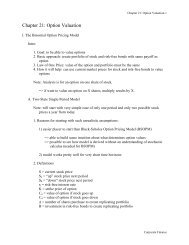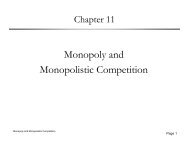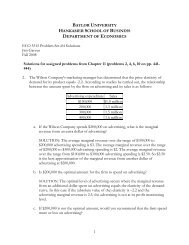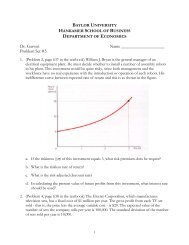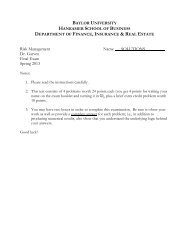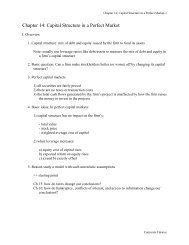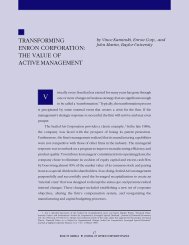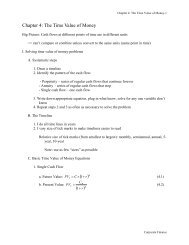Insurance Company Capital Structure Swaps and Shareholder Wealth
Insurance Company Capital Structure Swaps and Shareholder Wealth
Insurance Company Capital Structure Swaps and Shareholder Wealth
Create successful ePaper yourself
Turn your PDF publications into a flip-book with our unique Google optimized e-Paper software.
Under the Merton-Margrabe exchange option valuation model, we will substitute equation 7<br />
into equations 14 <strong>and</strong> 15 to generate the following optimization formulas.<br />
∂Wt=2<br />
∂Lt=1<br />
∂Wt=2<br />
∂Lt=1<br />
= EM,t=1 [EM,t=1N (d2,t=2) − Et=2N (d2M,t=1)] = 0 (16)<br />
= −EM,t=1N (d2,t=2) − Et=2N (d2M,t=1)<br />
EM,t=0<br />
= 0 (17)<br />
When issuing equity to purchase reinsurance, the manager will find the value of losses that<br />
solves equation 16. When retiring equity with proceeds of new insurance policy sales, the manager<br />
will find the value of losses solving equation 17. To confirm that we have maximized shareholder<br />
wealth, we confirm that the second derivative is negative.<br />
5 Comparative Statics<br />
Comparative statics on the preceding swap valuation models show that managers may be able to<br />
increase the wealth of controlling shareholders by engaging in capital structure swaps. We now<br />
propose two hypotheses about the value-enhancing nature of capital structure swaps, demonstrate<br />
their validity with numerical examples <strong>and</strong> then test whether these value-enhancing swaps actually<br />
occur in practice.<br />
Given our theory, increasing liabilities to retire equity will benefit the controlling shareholders<br />
when managers exploit risk preferences of policyholders, comparative advantage in provision of<br />
real-services <strong>and</strong> tax effects. This is only possible when insurers can charge a relatively high price<br />
for insurance policies, which is not possible under perfect competition. However, in the face of<br />
information asymmetry, regulatory constraints <strong>and</strong> bankruptcy costs, disequilibrium can exist. In<br />
fact, Doherty <strong>and</strong> Garven (1995) <strong>and</strong> prior literature show that underwriting returns appear to<br />
follow a second-order autoregressive process. This creates an “underwriting cycle” in which prices<br />
<strong>and</strong> profitability rise <strong>and</strong> fall over time. If information asymmetry, transaction costs <strong>and</strong> other<br />
frictions prevent the capital markets from fully incorporating the increased profitability for firms<br />
in the high-profit phase of the cycle, then managers may be able to increase shareholder wealth by<br />
19



